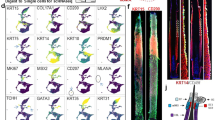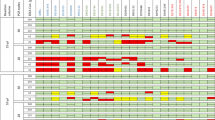Abstract
Blood, buccal swab and hair follicles are among the most commonly used sources for forensic science, parentage testing and personal identification. A total of 29 patients who have had a sustained engraftment from 15 months to 21.5 years after allogeneic hematopoietic stem cell transplantation (HSCT) without rejection, relapse or chronic GVHD involving oral mucosa were enrolled for a chimerism study. PCR-amplified short tandem repeat analyses were conducted per patient every 3 months for at least three consecutive times. The results for blood were all donor type except one who had a mixed chimerism, 14.5 years after receiving a transplant for lymphoma. As for buccal swab, mixed chimerism ranging from 10 to 96% donor origin was noted for 28 recipients except the one who had mixed chimerism of blood and retained total recipient type. In contrast, hair follicles were 100% recipient type for the entire group. It is concluded that the hair follicle is devoid of adult stem cell plasticity and may serve as a reliable source of recipient's origin when pre-transplant DNA fingerprinting or reference DNA is not available for people who have successfully received allogeneic HSCT while in need of a personal identification.
This is a preview of subscription content, access via your institution
Access options
Subscribe to this journal
Receive 12 print issues and online access
$259.00 per year
only $21.58 per issue
Buy this article
- Purchase on Springer Link
- Instant access to full article PDF
Prices may be subject to local taxes which are calculated during checkout

Similar content being viewed by others
References
Thomas ED, Storb R, Clift RA, Fefer A, Johnson L, Neiman PE et al. Bone marrow transplantation. N Engl J Med 1975; 292: 832–843;895–902.
Thomas ED . Marrow transplantation for malignant disease. J Clin Oncol 1983; 1: 517–531.
Gluckman E, Barrett AJ, Arcese W, Devergie A, Degoulet P . Bone marrow transplantation in severe aplastic anemia: a survey of the European Group for Bone Marrow Transplantation. Br J Haematol 1981; 49: 165–173.
Lucarelli G, Clift RA . Marrow transplantation in thalassemia. In: Thomas ED, Blume KG, Forman SJ (eds). Hematopoietic Cell Transplantation. Blackwell Science: Malden, 1999, pp 1137–1144.
Gatti RA, Meeuwissen HJ, Allen HD, Hong R, Good RA . Immunological reconstitution of sex-linked lymphopenic immunological deficiency. Lancet 1968; 2: 1366–1369.
Korbling M, Przepiorka D, Huh YO, Engel H, van Besien K, Giralt S et al. Allogeneic blood stem cell transplantation for refractory leukemia and lymphoma: potential advantage of blood over marrow allografts. Blood 1995; 85: 1659–1665.
Thomas ED, Ramberg RE, Sale GE, Sparkes RS, Golde DW . Direct evidence for a bone marrow origin of the alveolar macrophage in man. Science 1976; 192: 1016–1018.
Gale RP, Sparkes RS, Golde DW . Bone marrow origin of hepatic macrophages (Kupffer cells) in humans. Science 1978; 201: 937–938.
Theise ND, Badve S, Saxena R, Henegariu O, Sell S, Crawford JM et al. Derivation of hepatocytes from bone marrow cells in mice after radiation-induced myeloablation. Hepatology 2000; 31: 235–240.
Mezey E, Chandross KJ, Harta G, Maki RA, McKercher SR . Turning blood into brain: cells bearing neuronal antigens generated in vivo from bone marrow. Science 2000; 290: 1779–1782.
Orlic D, Kajstura J, Chimenti S, Jakoniuk I, Anderson SM, Li B et al. Bone marrow cells regenerate infarcted myocardium. Nature 2001; 410: 701–705.
Krause DS, Theise ND, Collector MI, Henegariu O, Hwang S, Gardner R et al. Multi-organ multi-lineage engraftment by a single bone marrow-derived stem cell. Cell 2001; 105: 369–377.
Jiang Y, Jahagirdar BN, Reinhardt RL, Schwartz RE, Keene CD, Ortiz-Gonzalez XR et al. Pluripotency of mesenchymal stem cells derived from adult marrow. Nature 2002; 18: 41–49.
Korbling M, Katz RL, Khanna A, Ruifrok AC, Rondon G, Albitar M et al. Hepatocytes and epithelial cells of donor origin in recipients of peripheral blood stem cells. N Engl J Med 2002; 346: 738–746.
Tran SD, Pillemer SR, Dutra A, Barrett AJ, Brownstein MJ, Key S et al. Differentiation of human bone marrow-derived cells into buccal epithelial cells in vivo: a molecular analytical study. Lancet 2003; 361: 1084–1088.
Rovó A, Meyer-Monard S, Heim D, Arber C, Passweg JR, Gratwohl A et al. No evidence of plasticity in hair follicles of recipients after allogeneic hematopoietic stem cell transplantation. Exp Hematol 2005; 23: 909–911.
Thiede C, Florek M, Bornhauser M, Ritter M, Mohr B, Brendel C et al. Rapid quantitation of mixed chimerism using multiplex amplification of short tandem repeat markers and fluorescence detection. Bone Marrow Transplant 1999; 23: 1055–1060.
Fowler JC, Burgoyne LA, Scott AC, Harding HW . Repetitive deoxyribonucleic acid (DNA) and human genome variation: a concise review relevant to forensic biology. J Forensic Sci 1988; 33: 1111–1126.
Alford RL, Hammond HA, Coto I, Caskey CT . Rapid and efficient resolution of parentage by amplification of short tandem repeats. Am J Hum Genet 1994; 55: 190–195.
Tzeng CH, Lyou JY, Chen YR, Hu HY, Lin JS, Yung CH et al. Polymorphisms of twelve short tandem repeat loci in a Taiwanese population and their application in parentage testing. J Formos Med Assoc 1998; 97: 738–744.
Tzeng CH, Lyou JY, Chen YR, Hu HY, Lin JS, Wang SY et al. Determination of sibship by polymerase chain reaction-amplified short tandem repeat analysis in Taiwan. Transfusion 2000; 40: 840–845.
Wang Li, Juji T, Tokunaga K, Takahashi K, Kuwata S, Uchida S et al. Polymorphic microsatellite markers for the diagnosis of graft-versus-host disease. N Engl J Med 1994; 330: 398–401.
Tzeng CH, Lyou JY, Chen YR, Lin JS, Hu HY, Yung CH et al. Allogeneic peripheral blood stem cell transplantation and early detection of hematopoietic origin using polymorphic short tandem repeats. J Formos Med Assoc 1998; 97: 252–260.
Thiede C, Prange-Krex G, Freiberg-Richter J, Bornhauser M, Ehninger G . Buccal swabs but not mouthwash samples can be used to obtain pretransplant DNA fingerprints from recipients of allogeneic bone marrow transplants. Bone Marrow Transplant 2000; 25: 575–577.
Acknowledgements
This work was supported by research Grants NSC 95-2745-B-075-007 from the National Science Council, and VGH-95-C-132 from the Taipei Veterans General Hospital, Taipei, Taiwan.
Author information
Authors and Affiliations
Corresponding author
Rights and permissions
About this article
Cite this article
Hong, Y., Liu, H., Chen, P. et al. Hair follicle: a reliable source of recipient origin after allogeneic hematopoietic stem cell transplantation. Bone Marrow Transplant 40, 871–874 (2007). https://doi.org/10.1038/sj.bmt.1705823
Received:
Revised:
Accepted:
Published:
Issue Date:
DOI: https://doi.org/10.1038/sj.bmt.1705823
Keywords
This article is cited by
-
Donor-derived DNA variability in fingernails of acute myeloid leukemia patients after allogeneic hematopoietic stem cell transplantation detected by direct PCR
Bone Marrow Transplantation (2020)
-
Isolation and Characterization of a Fetal-Maternal Microchimeric Stem Cell Population in Maternal Hair Follicles Long after Parturition
Stem Cell Reviews and Reports (2019)
-
Lost signature: progress and failures in in vivo tracking of implanted stem cells
Applied Microbiology and Biotechnology (2015)
-
Genetic investigation of biological materials from patients after stem cell transplantation based on autosomal as well as Y-chromosomal markers
International Journal of Legal Medicine (2013)
-
Successful bone marrow transplantation in a patient with Diamond-Blackfan anemia with co-existing Duchenne muscular dystrophy: a case report
Journal of Medical Case Reports (2011)



